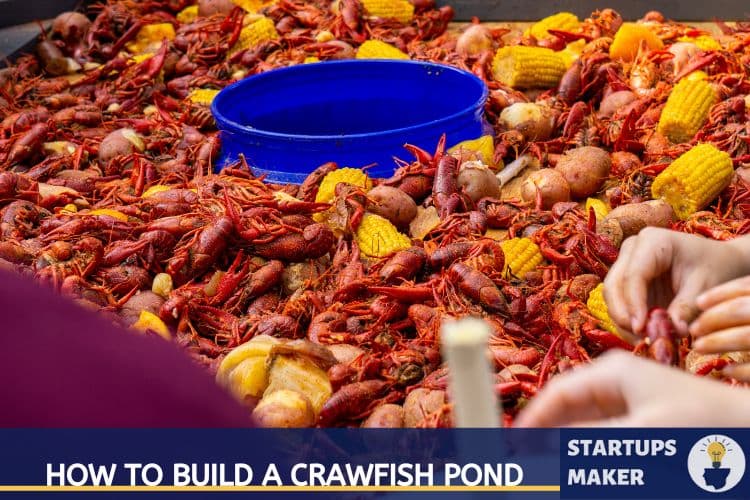Starting a farm-to-table company, such as a crawfish farm, maybe a great way to provide fresh, healthy food from the source to the customer. In order to understand how to start a crawfish pond, you must first learn how to cultivate crawfish. You’ll also need a large enough flood plain for an indoor crawfish farm along with constant weather and plenty of patience.
Starting a crawfish farm is no easy task, but if done well, it may provide substantial financial and personal benefits.
In this blog, we will provide some ideas about how to build a crawfish pond which will help to increase your chances of success with an exceptional business venture.
Step 1: Prepare a Rice Field for Planting
In most years, the indoor crawfish farm harvest starts sometime in April. However, “seed” crawfish aren’t brought into a pond to kick off the process. The process really starts off with the planting of rice. You’ll need a sizable pond or paddy if you are thinking of starting a crawfish farm. Crawfish shouldn’t be introduced to the pond until the rice canopy has grown enough to cover the water and keep the temperature down.
Read:- How to Open a Lush Store: A Complete Guide
Step 2: Look for a Crawfish Seed Vendor
The majority of the world’s seed crawfish originate from the southeastern and central regions of the United States. Starter animals are necessary for every farm, and their costs will fluctuate with the seasons. Crawfish might be introduced from the wild, but finding them can be a time-consuming process. If thinking about how to start a crawfish pond, the animals should be introduced to the water when it is still chilly for the best results in farming.
Step 3: Just wait and Watch
As we transition into summer from spring, the pond will gradually warm. Crawfish in an indoor crawfish farm will start digging holes as soon as the water temperature rises above freezing. Since this is the case, many people refer to them as “mud bugs.” In order to harvest the rice crop after it has matured, you will need to empty your pond as the hotter weeks of July approach. Now is the time when you have to wait for the weather, which plays a crucial part in your farm’s performance but which you have little control over.
Read:- How To Open A Daiquiri Shop? Cost & Tips {Full Guide}
Step 4: When Autumn arrives, flood the ponds
As soon as the rice is harvested and the lower temperatures of autumn set in, the ponds may be flooded again. Assuming the weather has cooperated, this will result in the emergence of crawfish, and you may expect to see hundreds of baby crawfish following their moms out of their burrows. Because of the remaining rice, the animals molt. If you’re starting a crawfish farm, expect them to mature after a period of roughly 3 months.
Step 5: In order to know when to harvest, you need to know the weather
Depending on how cold it gets where you live, it may be a full year before you can start collecting crayfish from your first rice field crop. Due to the warmer temperatures, the first crawfish harvest might come as early as November. However, once you have the farm up and running, you may keep harvesting until the crawfish disappear underground during the warmer months.
Step 6: Learning the Art of Crawfishing is a Necessity
People who are thinking about how to build a crawfish pond, remember, crawfish farming is most labor-intensive during harvest. Crawfish are captured in a unique way compared to other animal products. Depending on the season, farmers may bait traps with fish or pellets, and you’ll want to get a crawfish boat to make the most of your harvesting efforts.
Step 7: Crawfish won’t become clean in salt water
The method you choose to clean your crawfish will determine how successful your crawfish farm is in comparison to others in your neighbourhood. This is the crucial step in how to start a crawfish pond. Although it is customary to wash crawfish in salt water, this method is ineffective since it only gets rid of wastes that the crawfish have already emitted. Crawfish in oxygenated water is healthier because waste is eliminated via gills rather than accumulated in the body. This is a cost-effective idea to clean crawfish on an indoor crawfish farm.
Read:- Ant Farm Gel Recipe: Step By Step Guide
Step 8: Obtain Your USDA Farm Certification
If the USDA has approved your farm, you may send crawfish to pretty much any place in the US. This will provide you access to markets that are unavailable to most farmers, but it will also require you to maintain consistently high standards on your property. Obtaining the license will help you gain more profits by starting a crawfish farm.
Step 9: The Sizes and Grades You Need to Know
Some individuals think that since they are familiar with the sizes and grades of shrimp, they can apply the same logic to crawfish. There is just one thing you need to know about crawfish: larger is better. When properly harvested, a pound of crawfish will yield roughly 20 crawfish, making them an affordable luxury item.
Final Thoughts
Learning the ins and outs of starting a crawfish farm may lead to a novel and lucrative agricultural endeavor. Spend time honing these abilities, securing enough farmland, and acquiring the necessary tools for planting and harvesting. That’s how you will learn how to start a crawfish pond.
